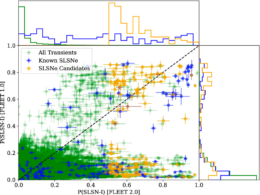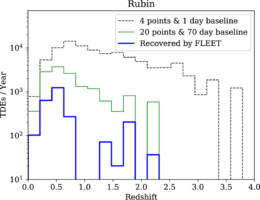In the coming decade, astronomers plan to discover thousands of rare, poorly understood, exotic transients. However, telling these apart from the torrent of “normal” flashes quickly enough for useful follow up observations will pose a daunting challenge. Thankfully, new algorithms powered by machine learning techniques may be able to triage for us.
Transient Triage
Though it may appear tranquil and unchanging to the casual observer, if one looks carefully, they find that the night sky is actually crackling with small, slow flashes. Thanks to modern cameras and computers, astronomers have grown increasingly attentive and now catch more of these flashes than ever before. The community flags about 20,000 so-called “transients” each year, and the rate is only expected to grow in the next decade.
A large number of astronomical events, such as thermonuclear and core collapse supernovae, produce roughly similar-looking flashes, so simply spotting one does not reveal much useful information. To better study the underlying physics powering each transient, astronomers must revisit each with different types of detectors. Unfortunately, the staggering pace of discovery is too fast to thoroughly follow up on every transient. Faced with finite telescope time, astronomers need to play a constant game of triage: which transients could uncover something interesting with additional follow up, and which are just more run-of-the-mill supernovae that we can allow to fade unwatched without worry of missing something exciting? An increasingly promising way to decide is to cede the choice to a machine learning algorithm.
FLEET and the Forest

A comparison of the old FLEET 1.0 algorithm and the improved FLEET 2.0. Here, both random forests were asked to consider archived observations of many previous transients. FLEET 2.0 generally outperformed its predecessor and uncovered tens of transients that may have actually been superluminous supernovae but went undiagnosed before fading. [Gomez et al. 2023a]
Gomez and collaborators were particularly interested in two types of rare explosions: superluminous supernovae and tidal disruption events. The community has only ever observed a handful of each, though more are likely hiding in the constant stream of transient discoveries. By training FLEET to latch onto subtle differences between transients and quickly extract the underlying event, the team could prioritize follow-up resources to target promising candidates and expand their so-far sparse catalogs.

They expected number of tidal disruption events the Vera C. Rubin Observatory will observe each year during its LSST program, and the number of those which FLEET is expected to confidently flag as a candidate worthy of follow up. Note that currently astronomers have observed fewer than 100 tidal disruption events. [Gomez et al. 2023a]
Citations
“Identifying Tidal Disruption Events with an Expansion of the FLEET Machine-learning Algorithm,” Sebastian Gomez et al 2023 ApJ 949 113. doi:10.3847/1538-4357/acc535
“The First Two Years of FLEET: An Active Search for Superluminous Supernovae,” Sebastian Gomez et al 2023 ApJ 949 114. doi:10.3847/1538-4357/acc536

